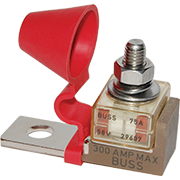In my situation, the fuse is close to the battery. Even though they are 78 amp alternators, I have never seen the ammeter go that high. They typically after cranking, run a charge from 30 to 40 amps and only for a minute or so. I could go with 100 amp fuses, that is the largest fuse that will fit that holder that I know of.
I have experience rebuilding these Delco alternators. I have about 4 spares.
My alternator wire goes from alternator to helm ammeter to fuse to battery lug in the battery switch.
OEM had run the output through ammeters up on the flybridge. That was a very long run, I cut them out of the circuit and rely on voltmeters for monitoring the power output both on lower and upper helm.
After pulling out the ammeters, to reuse the hole, I gutted the ammeter and put in a 3 wire digital volt meter. The third wire is a voltage sensing wire. Other 2 wires power the meter.
Created a black mask, then used some blue plastic to give led a bluer look.
Meter I pulled out of its case and hot glued to the old ammeter face.
The original SW ammeter case has 3 electrical connections built in. I was able to reuse them, so the internal wires from the LED gauge hook up inside the case., all the nuts work just like OEM.
New meter uses a ground, hot, voltage sense wire.



